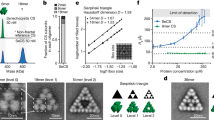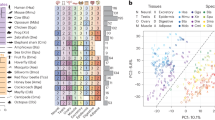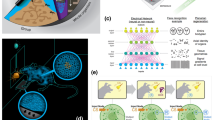Abstract
Vascular plants vary in size by about twelve orders of magnitude, and a single individual sequoia spans nearly this entire range as it grows from a seedling to a mature tree. Size influences nearly all of the structural, functional and ecological characteristics of organisms1,2. Here we present an integrated model for the hydrodynamics, biomechanics and branching geometry of plants, based on the application of a general theory of resource distribution through hierarchical branching networks3 to the case of vascular plants. The model successfully predicts a fractal-like architecture and many known scaling laws, both between and within individual plants, including allometric exponents which are simple multiples of 1/4. We show that conducting tubes must taper and, consequently, that the resistance and fluid flow per tube are independent of the total path length and plant size. This resolves the problem of resistance increasing with length, thereby allowing plants to evolve vertical architectures and explaining why the maximum height of trees is about 100 m. It also explains why the energy use of plants in ecosystems is size independent.
This is a preview of subscription content, access via your institution
Access options
Subscribe to this journal
Receive 51 print issues and online access
$199.00 per year
only $3.90 per issue
Buy this article
- Purchase on Springer Link
- Instant access to full article PDF
Prices may be subject to local taxes which are calculated during checkout


Similar content being viewed by others
References
Schmidt-Nielsen, K. Scaling: Why is Animal Size so Important? (Cambridge Univ. Press, Cambridge, 1984).
Niklas, K. J. Plant Allometry: The Scaling of Form and Process (Univ. of Chicago Press, Chicago, 1994).
West, G. B., Brown, J. H. & Enquist, B. J. Ageneral model for the origin of allometric scaling laws in biology. Science 276, 122– 126 (1997).
Zimmermann, M. H. Xylem Structure and the Ascent of Sap (Springer, New York, 1983).
Tyree, M. T. & Ewers, F. W. The hydraulic architecture of trees and other woody plants. New Phytol. 119, 345–360 (1991).
Shinozaki, K., Yoda, K., Hozumi, K. & Kira, T. Aquantitative analysis of plant form — the pipe model theory: I. Basic analysis. Jpn. J. Ecol. 14, 97–105 (1964).
Bertram, J. E. A. Size-dependent differential scaling in branches: the mechanical design of trees revisited. Trees 4, 241– 253 (1989).
Patino, S., Tyree, M. T. & Herre, E. A. Comparison of hydraulic architecture of woody plants of differing phylogeny and growth form with special reference to free standing and hemi-epiphytic Ficus species from Panama. New Phytol. 129, 125–134 ( 1995).
Kuuluvainen, T., Sprugel, D. G. & Brooks, J. R. Hydraulic architecture and structure of Abies lasiocarpa seedlings in three alpine meadows of different moisture status in the eastern Olympic mountains, Washington, U.S.A. Arct. Alp. Res. 28, 60–64 ( 1996).
Yang, S. & Tyree, M. T. Hydraulic architecture of Acer saccharum and A. rubrum : comparison of branches to whole trees and the contribution of leaves to hydraulic resistance. J. Exp. Bot. 45, 179–186 ( 1994).
Ewers, F. W. & Zimmermann, M. H. The hydraulic architecture of eastern hemlock Tsuga canadensis. Can. J. Bot. 62, 940–946 (1984).
Yang, S. & Tyree, M. T. Hydraulic resistance in Acer saccharum shoots and its influence on leaf water potential and transpiration. Tree Physiol. 12, 231– 242 (1993).
Long, J. N., Smith, F. W. & Scott, D. R. M. The role of Douglas fir stem sapwood and heartwood in the mechanical and physiological support of crowns and development of stem form. Can. J. For. Res. 11, 459– 464 (1981).
Rogers, R. & Hinckley, T. M. Foliar weight and area related to current sapwood area in oak. Forest Sci. 25, 298–303 (1979).
Niklas, K. J. Size-dependent allometry of tree height, diameter and trunk taper. Ann. Bot. 75, 217–227 ( 1995).
Tyree, M. T. & Alexander, J. D. Hydraulic conductivity of branch junctions in three temperate tree species. Trees 7, 156–159 (1993).
Tyree, M. T., Graham, M. E. D., Cooper, K. E. & Bazos, L. J. The hydraulic architecture of Thuja occidentalis. Can J. Bot. 61, 2105–2111 ( 1983).
Fitter, A. H. & Strickland, T. R. Fractal characterization of root system architecture. Funct. Ecol. 6, 632–635 (1992).
Morse, D. R., Lawton, J. H., Dodson, J. H. & Williamson, M. M. Fractal dimension of vegetation and the distribution of arthropod body lengths. Nature 314, 731–733 (1985).
McMahon, T. A. & Kronauer, R. E. Tree structures: deducing the principle of mechanical design. J. Theor. Biol. 59, 443–436 (1976).
Enquist, B. J., Brown, J. H. & West, G. B. Allometric scaling of plant energetics and population density. Nature 395, 163– 165 (1998).
Turcotte, D. L., Pelletier, J. D. & Newman, W. I. Networks with side branching in biology. J. Theor. Biol. 193, 577–592 (1998).
Acknowledgements
We thank K. Niklas and M. Tyree for comments. J.H.B. was supported by the NSF, B.J.E. by the NSF and with an NSF post-doctoral fellowship, and G.B.W. by the US Department of Energy. We also thank the Thaw Charitable Trust for support.
Author information
Authors and Affiliations
Corresponding author
Rights and permissions
About this article
Cite this article
West, G., Brown, J. & Enquist, B. A general model for the structure and allometry of plant vascular systems . Nature 400, 664–667 (1999). https://doi.org/10.1038/23251
Received:
Accepted:
Issue Date:
DOI: https://doi.org/10.1038/23251
This article is cited by
-
High leaf area index expands the contrasting effect of climate warming on Western Siberia taiga forests activity before and after 2000
Journal of Geographical Sciences (2024)
-
Global patterns of allometric model parameters prediction
Scientific Reports (2023)
-
Synthesis of branched silica nanotrees using a nanodroplet sequential fusion strategy
Nature Synthesis (2023)
-
Non-Destructive Allometric Modeling for Tree Volume Estimation in Tropical Dry Deciduous Forests of India Using Terrestrial Laser Scanner
Journal of the Indian Society of Remote Sensing (2023)
-
Conversion of oak coppices to high forests as a tool for climate change mitigation in central Greece
International Journal of Environmental Science and Technology (2023)
Comments
By submitting a comment you agree to abide by our Terms and Community Guidelines. If you find something abusive or that does not comply with our terms or guidelines please flag it as inappropriate.



